Website: www.SedNet.org
Compiled by: Marjan Euser (marjan.euser@deltares.nl)
Subscription Service: SedNet Secretariat (marjan.euser@deltares.nl)
Disclaimer: SedNet is not responsible for faults due to incorrectness of info in this newsletter
Previous issues: www.sednet.org/newsletter
Contents
- Call for Abstracts – 11th International SedNet Conference
- Workshop SedNet Working Group Sediment Quantity
- Sediments and Circular Economy, a question of Good Practice too
- Sediment Budget of the Rhine River from source to mouth 1991 – 2010
- InterReg project VALSE sampling historic sediments for pilot reuse projects
- World Resources Forum: Call for deep-dive workshops
- Shortcourses in integrated science for river management and restoration, specialized training in sediment transport as applied to river restoration
- Net erosion and sediment transport using WaTEM/SEDEM
- Upcoming events
Call for Abstracts – 11th International SedNet Conference
From 3-5 April 2019 the 11th International SedNet Conference Sediment as a dynamic natural resource – from catchment to open sea will be organised in Dubrovnik, Croatia. Co-organisers are Ruđer Bošković Institute and University of Dubrovnik, and IAEA is giving support.
Sediments found in upland streams, industrialised waterways, busy coastal zones and offshore waters are characterized by a wide variety of sediment properties present in dynamic and less dynamic areas. These areas are inherently interlinked as sediment is transported from catchment to the open sea. The natural flow of sediment from mountainous regions to the ocean is strongly impacted by anthropogenic activities along this journey in terms of both the quantity that is transported and the quality of transporting waters. Sediment distribution is not only impacted by direct human influence but also indirectly as a result of changing weather and climate patterns. A change in sediment dynamics leading to sediment starvation or sediment accumulation is often the concern of river basin and coastal managers who constantly need to adapt to these environmental variations. Historical or emerging contaminants may also hinder the management of these areas.
At the SedNet 2019 conference “Sediment as a dynamic natural resource – from catchment to open sea”, we invite abstracts for a series of sessions aiming to explore these challenges and proposed solutions. This includes how policies and plans are developed for the range of often interlinked issues experienced along the journey from upland areas to the deeper waters such as how sediment quality should be assessed, sediment as an ecosystem service and how excess sediment can be used beneficially. The challenges posed as a result of anthropogenic influences, resource exploitation and climate change shall also be explored as well as emerging problems being examined such as contaminants resulting from discharge of waste.
The proposed thematic sessions are:
- Sediment management concept and sediment policy
- Sediment quality guidance, sediment quality assessment
- How can sediment management influence ecosystem services provision?
- Climate change and sediments: direct and indirect consequences
- Circular economy – sediment as a resource
- Societal impacts of disturbed sediment continua and mitigation measures?
- The impact and transport of microplastics
- Ballast water and sediments – BWM Convention
- Deep sea sediments
- Nuclear and isotopic analytical techniques in sediment analysis
Deadline for submission of abstracts: 1 October 2018
Abstracts will be selected by the SedNet Steering Group for either a platform presentation or a poster presentation.
Please see https://sednet.org/sednet-conference-2019/ for the full text of the Call and the template for submission of abstracts to the SedNet Secretariat: marjan.euser@deltares.nl
Workshop SedNet Working Group Sediment Quantity
On 7-8 March 2018 a workshop of the SedNet Working Group Sediment Quantity was organised at Deltares in Delft. Approx. 25 participants attended the workshop. For background information about the WG we refer to the February-2018 edition of SedNet eNews.
The result of the event is a variety of practicle and feasible ideas and actions:
- Produce a document as input to the discussion of WG Ecostat about a guidance document for measures to restore hydromorphology in heavily modified water bodies in order to achieve good ecological status.
- Further develop the working document of WG Quantity: add cases, visualize problems (with graphics, pictures).
- Write publication for an international magazine about disturbed sediment balances in large, global rivers.
- Start building a FP9-consortium in order to be prepared the moment DG ENV publishes a relevant Call (in the next couple of years).
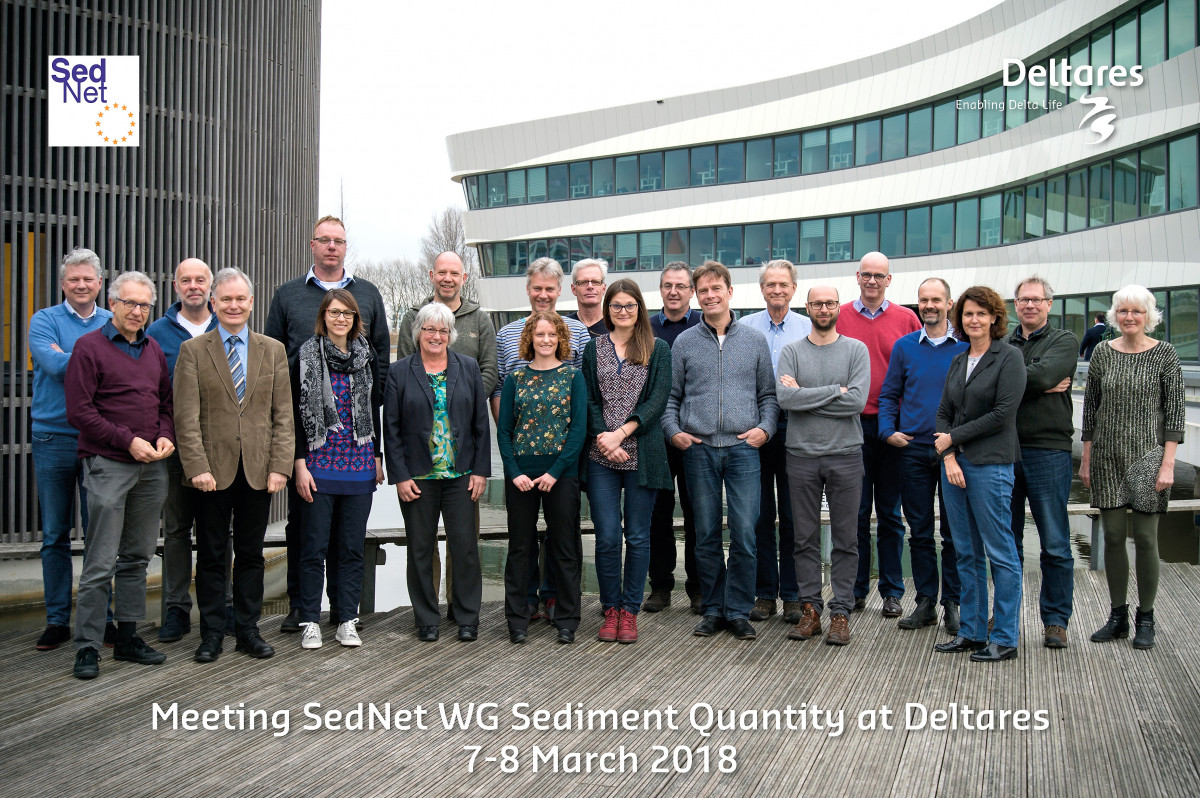
The Working Group is chaired by:
Helmut Habersack (BOKU, University of Natural Resources and Life Sciences, Vienna) and Ad van der Spek (Deltares).
The next workshop will be held on 5-6 November 2018 in Hamburg, Germany.
If you are interested in getting involved, feel free to contact the SedNet Secretariat.
Sediments and Circular Economy, a question of Good Practice too
In order to promote the reuse of sediments for sustainable purposes, SedNet will open on its website a resources library containing good practice guides, and more. Three such guides exist in French and we wish to translate them in English.
If you are interested in collaborating, let us know (SedNet Secretariat).
Summer scholarships may be offered to students willing to learn through translating (native English or bilingual, fluent French, add your CV).
A SedNet Working Group is now dedicated to Sediments and Circular Economy. It will have its first session in Hamburg, Germany, November 6th. Keep the date and drop us a line (SedNet Secretariat) if you are interested. See you in Hamburg!
Sediment Budget of the Rhine River from source to mouth for the period 1991 – 2010
The EU Water Framework Directive promotes a holistic, transboundary approach to European river catchments. The Federal Institute of Hydrology (BfG) and the Institute of Hydraulic Engineering and Water Resources Management of RWTH Aachen University (IWW) have compiled the first sediment budget of the entire Rhine channel from its source in the Alps to its estuary in the North Sea. The study was conducted under the banner of the International Commission for the Hydrology of the Rhine Basin (CHR) and is now published as the 22nd CHR-report.
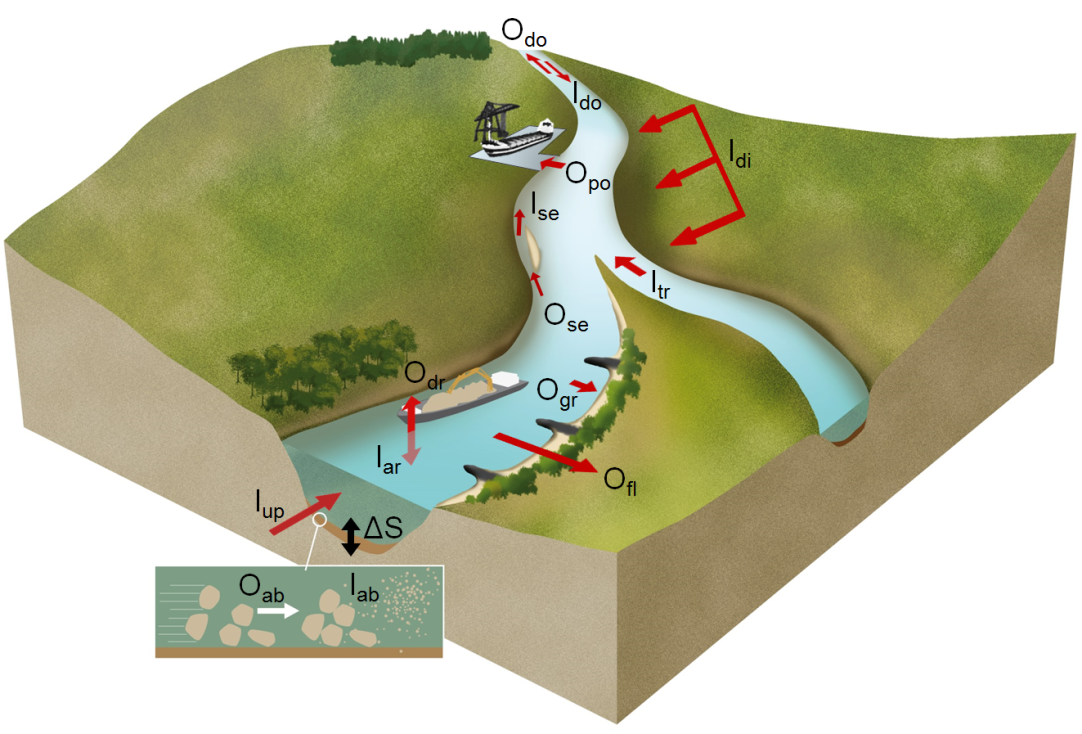
Schematic representation of the sediment budget terms of a river section.
The report presents a unique, detailed, and grain size fractionated analysis of the morphology of the entire river Rhine, one of the world’s larger rivers. The objectives were: (a) to quantify the downstream fluxes of clay, silt, sand, gravel and cobbles and (b) to identify the sources and sinks of these sediments. A large number of morphological studies about the Rhine were reviewed and existing data, such as echo soundings and sediment transport data from the period 1991 to 2010, was re-analysed.
The following conclusions were drawn: (1) Sediment fluxes in the Rhine are discontinuous due to regional sinks and sources, leading to a large variability of the sediment fluxes along the river channel. (2) From source to mouth, the Rhine traverses four sections with fundamentally different morphodynamic behaviour: the Alpine, impounded, free-flowing and delta sections. (3) The largest sediment fluxes, which are dominated by the clay fraction, are observed in the Alpine section. (4) Nourishment represents the biggest source of gravel and cobbles, while tributaries are the biggest fluvial source of clay, silt and sand. In addition large amounts of clay, silt and sand are supplied to the lower Rhine delta by the sea. (5) Dredging represents a main sediment sink for all size fractions. For silt and clay, deposition in floodplains and ports represent an additional major sediment sink. Sediment output to the North Sea is limited. (6) In contrast to the typical prototype of a river with erosion in the upper reaches and sedimentation in the lower reaches, the Rhine has net deposition in the upper reaches and net erosion in the downstream reaches. Local variations are high though. (7) More sediment is transported upstream from the North Sea into the lower Rhine delta than vice versa. (8) Floodplain deposition causes a higher loss of sediment in the upstream parts of the river than in the delta. (9) Today’s sediment fluxes in the Rhine are strongly influenced by river training works from the past, as well as by dredging and nourishment operations. (10) Yet natural factors determine the large-scale, primary location of the main sedimentation areas. (11) In many reaches gravel is deposited, whereas sand is being eroded simultaneously. (12) The budget analysis shows that sediment dynamics in rivers are much higher than is suggested by echosoundings or transport measurements, and it also shows that (13) sand plays a dominant role in the morphodynamics of the Rhine, not only in the sand-bed reaches, but also in the gravel-bed reaches of the river. (14) The sediment budget derived in this study provides very valuable empirical evidence for improving numerical prediction models, optimizing nourishment, dredging and monitoring strategies, and for discovering knowledge gaps and setting research agendas to facilitate the cross-boundary and sustainable sediment management along the river Rhine.
The full report is available at: http://doi.bafg.de/BfG/2017/KHR_22.2017.pdf
InterReg project VALSE sampling historic sediments for pilot reuse projects
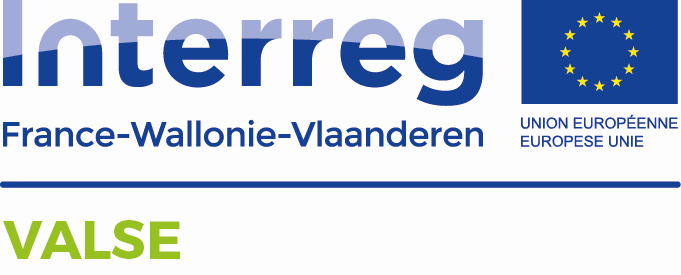
avec le soutien du fonds européen de développement régional
met steun van het Europees Fonds voor Regionale Ontwikkeling
program financed by the European Regional Development Fund
Project partners INERIS, Lille University, VNF, BRGM led in March 2018 a characterisation and sampling campaign on the historic sediments storage site TD 26 operated by VNF (French Waterways Agency) near Saint Omer, Northern France, along the channelised Aa river. Laboratory support is provided by Belgian partners ISSeP and CTP, and French partner Mines Douai.
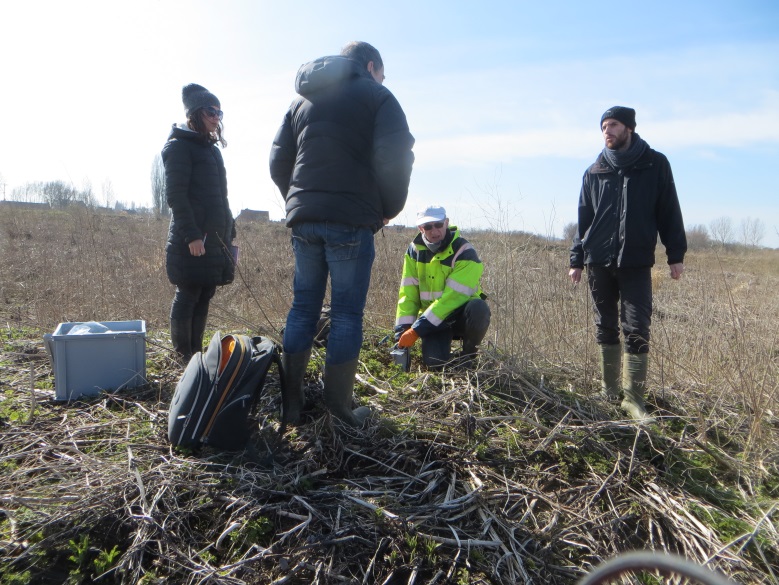
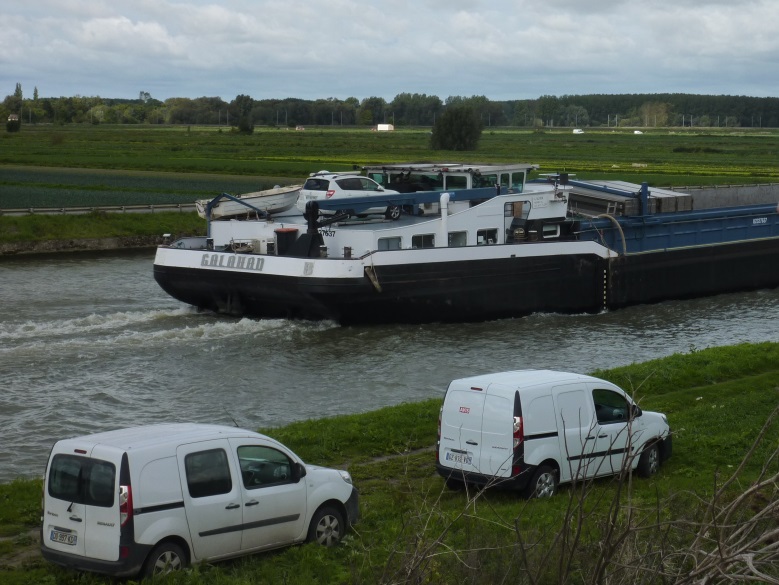
The objective of this campaign is to evaluate historic dredged sediments for their suitability for reuse through pilot projects (civil engineering and road works concrete, cycle path base, landscaping mounds) that will be undertaken during the project. It focussed on potential environmental issues and on site homogeneity. It addressed both solids (matured sediments) and shallow water.
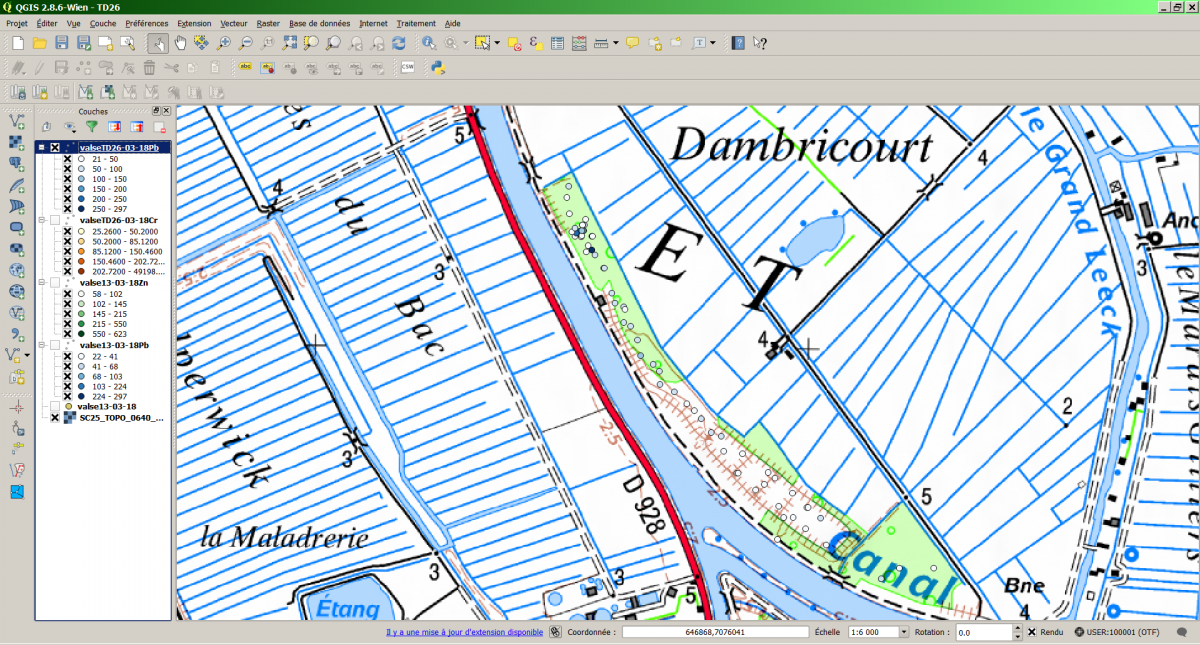
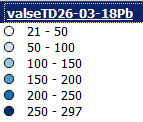
Map of Pb concentrations (mg/kg on wet material) measured by portable XRF (no Pb < 20). Note the higher values in the NW part (older) of the site. The only other elements of concern detected by pXRF (Zn, Cr) show a similar pattern.
Results show that the sediments would qualify as non hazardous or inert under waste regulations for most regulated metals and metalloids. Organic contaminants will be analysed in the laboratory. The campaign allowed testing new on-site electrochemical analytical techniques (trace elements in water, sulphides).
The VALSE project aims at developing a toolbox of on-site technologies for sediment management decision making.
TD 26 sediments are suitable for pilot testing and further developments will be presented in this newsletter.
https://valse.info/le-projet/
World Resources Forum: Call for deep-dive workshops
WRF 2019 will host a series of ‘deep-dive’ workshops as part of the conference program and invites interested organisations to design and submit a workshop proposal. Under the Title ‘Closing Loops – Transitions at work’, WRF 2019 wants to show systemic drivers, as well as concrete solutions to make the transition to circular economy work in practice.
A circular economy aims at maintaining our resources, such as materials, land and soil, at a high quality level while rendering the services we need to fulfill our current and future needs. This can be achieved by reorganising production/consumption patterns and value chains so that resources do not get wasted, rather get replenished and restored.
Workshops address topical issues related to the 6 conference themes:
- Cities and regions as laboratories for change
- Ports and circular economy in a global market
- Digital technology as driver for circular economy
- Sustainable materials and waste management
- Circular bio-economy and bio-based materials
- Land and soil (and sediments) as valuable resources
For further information see: http://www.ovamenglish.be/design-your-own-workshop and http://www.ovamenglish.be/soil-and-land-as-a-valuable-resource
Shortcourses in integrated science for river management and restoration, specialized training in sediment transport as applied to river restoration
River Restoration: Fluvial-Geomorphic and Ecological Tools, 11-15 June 2018, Beaumont du Ventoux, Provence, France
https://institutbeaumont.org
This shortcourse/workshop emphasizes understanding geomorphic process as a sound basis for planning and designing river restoration projects and programs, with specific applications and field visits to Mediterranean and mountain environments. The course draws on innovative process-based river restoration and management experiences in France and elsewhere in the EU, complemented by experiences in North America. Instruction includes lectures, field exercises, and workshops on approaches to planning and implementing process-based restoration. Instructors are drawn from multiple disciplines, and from academia and practice, on both sides of the Atlantic. It’s a great opportunity to make connections with others working on similar issues in different geographic and institutional settings. Held the week after ISRivers, it offers a great opportunity to combine two professional and education experiences in a compelling setting. (in English)
Sediment Transport in Stream Assessment and Design, 30 July – 03 Aug 2018, Logan, Utah USA
https://qcnr.usu.edu/courses/sediment_transport
This course is intended for those who wish to understand and apply the principles of sediment transport to alluvial channel assessment and design. Principles of open channel flow and sediment transport are combined with watershed-scale, hydrologic and sediment source analysis to place channel assessment and design in context. The course balances advance reading, lecture, field work, and hands-on exercises for estimating sediment supply, calculating sediment transport rates, forecasting channel response to water and sediment supply, and channel design. Intended for participants familiar with basic principles of river geomorphology (such as from the Beaumont or Sagehen courses). Instructors are drawn from both research and practice. Continuing Education Units for the course offered by Utah State University.
Geomorphic and Ecological Fundamentals for River and Stream Restoration, 6-10 August 2018, Truckee, California USA
http://laep.ced.berkeley.edu/courses/riverrestoration
This five-day introductory course emphasizes understanding geomorphic and ecological process as a sound basis for planning and designing river restoration, covering general principles and case studies from a wide range of environments, and includes field measurements, mapping, interpretation, field trips to the Truckee River and streams in the Lake Tahoe Basin, and workshops on stream restoration problems faced by participants. Now in its 24th successful year, the course is held at Sagehen Creek Field Station, combining a beautiful natural setting with excellent research and facilities, such as an outdoor classroom, stream table to demonstrate channel adjustments, on-site laboratory, and Sagehen Creek itself, with its rich history of research in fluvial geomorphology and ecology. Instructors are drawn from multiple disciplines, and from both research and practice.
If you have questions, please contact us at <river.restoration.sagehen@gmail.com>
Net erosion and sediment transport using WaTEM/SEDEM
The JRC in collaboration with the University of Basel and the Universite Catholique de Louvain have quantified the potential spatial displacement and transport of soil sediments due to water erosion at European scale. Long-term averages of annual soil loss and deposition rates were computed by means of the extensively tested spatially distributed WaTEM/SEDEM model. According to a recent research study in Europe, the estimated sediment yield totals about 164 ± 13 Tg yr-1. The Sediment Delivery Ratio (SDR) i.e., the ratio between sediment yield (SY) and gross erosion, indicates that the sediment routed down the hillslopes to the riverine system accounts for 15.3% of the total eroded soil. Further improvement of the calibration scheme in the model transport parameter is foreseen to better reconcile the good agreement between predicted and measured sediment yield. The net erosion and sediment transport data are available (100m resolution) in ESDAC.
Upcoming events
4-8 June 2018: 3rd edition of the I.S.Rivers international conference on integrative sciences and sustainable development of rivers, Lyon, France. See the conference website.
19-21 June 2018: 7th International Symposium “Monitoring of Mediterranean coastal Areas: problems and measurement techniques”, Livorno, Italy. Organised by the Institute of Biometeorology of the Italian National Research Council of Italy, in collaboration with other Research Institutes and University Departments. See the conference website.
6 November 2018: Kick-off meeting SedNet Working Group Sediments in Circular Economy, Hamburg, Germany
If you would like to be kept informed about the organisation and programme, please notify the SedNet Secretariat.
5-6 November 2018: Workshop SedNet Working Group Sediment Quantity, Hamburg, Germany.
If you wish to get involved, please send an email to the SedNet Secretariat.
19-20 November 2018: ENSOR – International workshop on Emerging policy challenges on New SOil contaminants, Brussels, Belgium.
Deadline for submitting abstracts: 15 June 2018
More info: https://www.2mpact.be/ensor
11-14 February 2019: 10th International BATTELLE Conference on Remediation and Management of Contaminated Sediments, New Orleans, Louisiana, US. Deadline for Abstract-submission: 29 June 2018.
See the conference website.
24-27 February 2019: World Resources Forum, Antwerp, Belgium. Under the Title ‘Closing Loops – Transitions at work’, WRF 2019 wants to show systemic drivers, as well as concrete solutions to make the transition to circular economy work in practice.
More info: http://www.ovamenglish.be/
3-5 April 2019: 11th International SedNet Conference “Sediment as a dynamic natural resource – from catchment to open sea”, Dubrovnik, Croatia. Co-organised by Ruđer Bošković Institute and University of Dubrovnik, with support of IAEA.
Call for Abstracts see https://sednet.org/sednet-conference-2019/
Deadline for submission of abstracts: 1 October 2018
26-30 May 2019: 29th SETAC Europe Annual Meeting, Helsinki, Finland.
Website: https://www.setac.org/?page=AnnualMeetings
Compiled by:
SedNet secretariat:
Mrs. Marjan Euser
Deltares
P.O. Box 85467
NL-3508 AL Utrecht
The Netherlands
Email marjan.euser@deltares.nl


